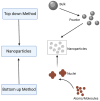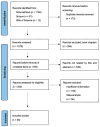Characteristics of Metallic Nanoparticles (Especially Silver Nanoparticles) as Anti-Biofilm Agents
- PMID: 39334993
- PMCID: PMC11428507
- DOI: 10.3390/antibiotics13090819
Characteristics of Metallic Nanoparticles (Especially Silver Nanoparticles) as Anti-Biofilm Agents
Abstract
Biofilm-associated infections account for a large proportion of chronic diseases and pose a major health challenge. Metal nanoparticles offer a new way to address this problem, by impairing microbial growth and biofilm formation and by causing degradation of existing biofilms. This review of metal nanoparticles with antimicrobial actions included an analysis of 20 years of journal papers and patent applications, highlighting the progress over that time. A network analysis of relevant publications showed a major focus on the eradication of single-species biofilms formed under laboratory conditions, while a bibliometric analysis showed growing interest in combining different types of metal nanoparticles with one another or with antibiotics. The analysis of patent applications showed considerable growth over time, but with relatively few patents progressing to be granted. Overall, this profile shows that intense interest in metal nanoparticles as anti-biofilm agents is progressing beyond the confines of simple laboratory biofilm models and coming closer to clinical application. Looking to the future, metal nanoparticles may provide a sustainable approach to combatting biofilms of drug-resistant bacteria.
Keywords: antimicrobial agents; bimetallic nanoparticles; biofilm; metallic nanoparticles; silver nanoparticles.
Conflict of interest statement
The authors declare no conflicts of interest.
Figures













Similar articles
-
Evolution of biofilm-forming pathogenic bacteria in the presence of nanoparticles and antibiotic: adaptation phenomena and cross-resistance.J Nanobiotechnology. 2021 Sep 27;19(1):291. doi: 10.1186/s12951-021-01027-8. J Nanobiotechnology. 2021. PMID: 34579731 Free PMC article.
-
Interactions of Gold and Silver Nanoparticles with Bacterial Biofilms: Molecular Interactions behind Inhibition and Resistance.Int J Mol Sci. 2020 Oct 16;21(20):7658. doi: 10.3390/ijms21207658. Int J Mol Sci. 2020. PMID: 33081366 Free PMC article. Review.
-
Oligodynamic Boons of Daptomycin and Noble Metal Nanoparticles Packaged in an Anti-MRSA Topical Gel Formulation.Curr Pharm Biotechnol. 2019;20(9):707-718. doi: 10.2174/1389201020666190621103416. Curr Pharm Biotechnol. 2019. PMID: 31223082
-
Silver nanoparticles impede the biofilm formation by Pseudomonas aeruginosa and Staphylococcus epidermidis.Colloids Surf B Biointerfaces. 2010 Sep 1;79(2):340-4. doi: 10.1016/j.colsurfb.2010.04.014. Epub 2010 Apr 22. Colloids Surf B Biointerfaces. 2010. PMID: 20493674
-
Silver nanoparticles as an alternative strategy against bacterial biofilms.Acta Biochim Pol. 2013;60(4):523-30. Acta Biochim Pol. 2013. PMID: 24432308 Review.
Cited by
-
New Antimicrobial Materials Based on Plasticized Polyvinyl Chloride for Urinary Catheters: Preparation and Testing.Polymers (Basel). 2024 Oct 29;16(21):3028. doi: 10.3390/polym16213028. Polymers (Basel). 2024. PMID: 39518238 Free PMC article.
-
Cellulose Nanocrystal/Zinc Oxide Bio-Nanocomposite Activity on Planktonic and Biofilm Producing Pan Drug-Resistant Clostridium perfringens Isolated from Chickens and Turkeys.Antibiotics (Basel). 2025 Jun 3;14(6):575. doi: 10.3390/antibiotics14060575. Antibiotics (Basel). 2025. PMID: 40558165 Free PMC article.
-
Biogenic synthesis of silver nanoparticles using Sida cuneifolia leaf extract for enhanced antibacterial, cytotoxic, and anti-biofilm activities.Biotechnol Notes. 2025 Jul 28;6:196-208. doi: 10.1016/j.biotno.2025.07.003. eCollection 2025. Biotechnol Notes. 2025. PMID: 40843008 Free PMC article.
-
Mechanisms and Assessment of Genotoxicity of Metallic Engineered Nanomaterials in the Human Environment.Biomedicines. 2024 Oct 20;12(10):2401. doi: 10.3390/biomedicines12102401. Biomedicines. 2024. PMID: 39457713 Free PMC article. Review.
-
From Green Chemistry to Healthy Environments: Silver Nanoparticles as a Dual Antioxidant and Antibacterial Agents for Advancing Biomedicine and Sustainable Wastewater Treatment.Bioengineering (Basel). 2024 Nov 28;11(12):1205. doi: 10.3390/bioengineering11121205. Bioengineering (Basel). 2024. PMID: 39768025 Free PMC article.
References
-
- Madalina Mihai M., Maria Holban A., Giurcaneanu C., Gabriela Popa L., Mihaela Oanea R., Lazar V., Carmen Chifiriuc M., Popa M., Ioan Popa M. Microbial biofilms: Impact on the pathogenesis of periodontitis, cystic fibrosis, chronic wounds and medical device-related infections. Curr. Top. Med. Chem. 2015;15:1552–1576. doi: 10.2174/1568026615666150414123800. - DOI - PubMed
-
- Rajput N. Methods of preparation of nanoparticles-a review. Int. J. Adv. Eng. Technol. 2015;7:1806.
Publication types
LinkOut - more resources
Full Text Sources
Molecular Biology Databases

